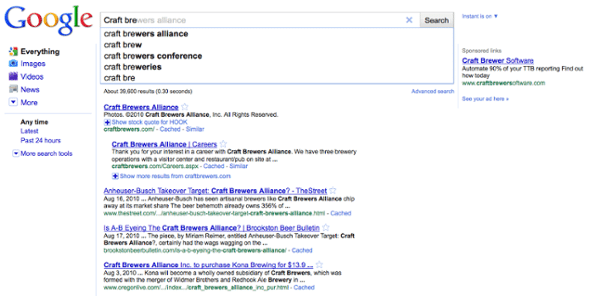As some of you already know, last Wednesday Google released an update to their search product, called Google Instant, which displays the potential search results page as you type. So, essentially, this new enhancement takes the predictive search interface (where Google took what you were typing and suggested potential search queries for you) one step further by adding the results to those predictive searches.
For example, prior to the release of Google Instant, if I were searching on the term “Redskins Win,” Google would begin to suggest search queries that start with “R-E-D” as seen in the screenshot below.

Now, as I begin to type “R-E-D” Google displays what the search results would be for the first search query in their predictive search suggestions as shown below.

The goal of Google Instant is that it’s supposed to save all of us seconds with each search by guiding us towards the search we really want and save us the trouble of clicking on search or hitting return. Personally, I find it a little annoying as I know what I want to search on and don’t like being interrupted as I’m typing – which is what it is basically doing. So, I will turn it off, (like I did with their personalized search results feature) and you can too if you don’t like it, by clicking on the link next to the search box.
So how does displaying the search results page as you type impact SEO if you are a business depending on SEO for customers? Well, some have gone as far as declaring that this move has “killed SEO.” But claims like this piss me off as much as some of the recent East Coast hurricane forecasts have (another touchy subject with me) since they are ignorant and sensationalistic. However, wild claims like this, while really stirring up the hornets nest, also force people to really think through what Google has done here, and how it impacts SEO marketing strategy.
Because seriously, as some of the more savvier search marketers and even Google’s product manager are pointing out, Google Instant doesn’t kill anything, instead, it forces us as marketers to evolve as the technology evolves. Which is a good thing people! (Unless, quite honestly, you’re lazy). Now, with Google Instant, we’re able to gain insight into tangential keywords that we may have missed before.
For example, say I was a beer aficionado and wanted to optimize my site around “craft brew” keywords. If I start typing “Craft brew” into the Google search field, I now see that “craft brewers alliance” is a top suggested keyword which I might not have known that before. And if this term is relevant to my audience, I may want to have a page on my site devoted to this “alliance” to capture any of my potential audience that might get sidetracked by clicking on this term.

This approach is just one of many new opportunities that have been created for SEOs by this release. I think this Faster Times article actually does a good job explaining a few others and also explains pretty clearly how the fundamentals of SEO have not changed. At the end of the day, it’s all about providing relevant content to a general target audience, and not unique individuals. And while Google Instant may change search behavior, by sending a potential customer down a different relevant pathway than they may have gone down prior to Instant’s release, Google is giving marketers the same opportunity to KNOW what that pathway is and allows us (and you) to provide that same content to our customers.
Having said all of this, in reality, it’s still too early to tell what the broader impact of Google Instant is going to be… and I WISH more people would admit that they don’t know, rather than making grand proclamations that hurt more than they help. But I guess this could be said about many headlines in general, and without these proclamations, we sometimes don’t have much to complain about. And on a Monday morning after a Redskins win over Dallas, I really don’t have much to complain about!






